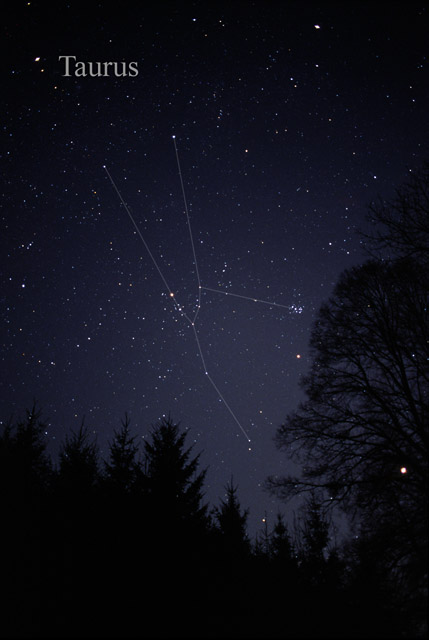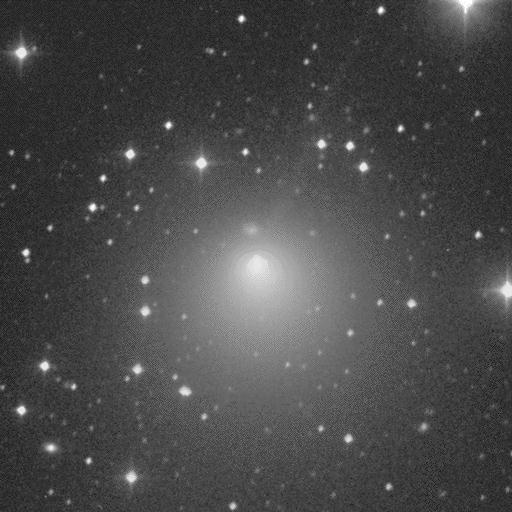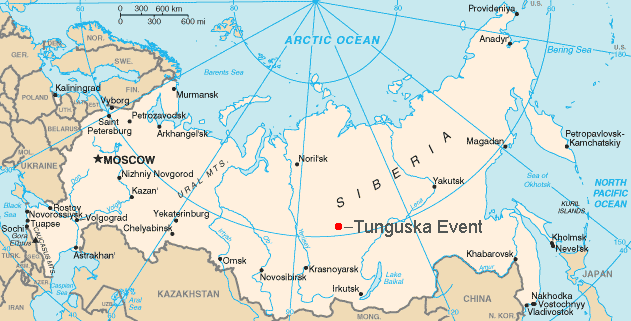|
Taurids
The Taurids are an annual meteor shower, associated with the comet Encke. The Taurids are actually two separate showers, with a Southern and a Northern component. The Southern Taurids originated from Comet Encke, while the Northern Taurids originated from the asteroid 2004 TG10, possibly a large fragment of Encke due to its similar orbital parameters. They are named after their radiant point in the constellation Taurus, where they are seen to come from in the sky. Because of their occurrence in late October and early November, they are also called Halloween fireballs. Encke and the Taurids are believed to be remnants of a much larger comet, which has disintegrated over the past 20,000 to 30,000 years, breaking into several pieces and releasing material by normal cometary activity or perhaps occasionally by close encounters with the tidal force of Earth or other planets (Whipple, 1940; Klačka, 1999). In total, this stream of matter is the largest in the inner Solar Sys ... [...More Info...] [...Related Items...] OR: [Wikipedia] [Google] [Baidu] |
Beta Taurids
The Beta Taurids (β–Taurids) are an annual meteor shower belonging to a class of "daytime showers" that peak after sunrise. The Beta Taurids are best observed by radar and radio-echo techniques. The Beta Taurids are normally active from June 5 to July 18. They emanate from an average radiant of right ascension 5h18m, declination +21.2 and exhibit maximum activity around June 28–29 (Solar Longitude=98.3 deg). The maximum hourly rate typically reaches about 25 as seen on radar. Non-radio observers are faced with a very difficult prospect, because the Beta Taurid radiant is just 10–15 degrees west of the Sun on June 28. These Beta Taurids are the same meteoroid stream as the Taurids (which form a meteor shower in late October). The Earth intersects this stream of debris twice, once in late October and once in late June, forming two separate meteor showers. However, because the October event occurs at night, it is far more visible and better known than the Beta Taurids, which ... [...More Info...] [...Related Items...] OR: [Wikipedia] [Google] [Baidu] |
2004 TG10
, is an eccentric asteroid, classified as near-Earth object and potentially hazardous asteroid of the Apollo group. First observed by the Spacewatch survey on 8 October 2004, it may be a fragment of Comet Encke and is the source of the Northern Taurids meteor shower seen annually in November and the June Beta Taurids.Meteor showers and their parent cometpg 470by Peter Jenniskens The asteroid may be larger than one kilometer in diameter. Orbit orbits the Sun at a distance of 0.3–4.2 AU once every 3 years and 4 months (1,220 days). Its orbit has an eccentricity of 0.86 and an inclination of 4 ° with respect to the ecliptic. It has a ''Earth minimum orbital intersection distance'' of , which corresponds to 8.8 lunar distances. Physical characteristics According to the survey carried out by the NEOWISE mission of NASA's Wide-field Infrared Survey Explorer, the asteroid measures 1.316 kilometers in diameter and its surface has an exceptionally low albedo Albedo ... [...More Info...] [...Related Items...] OR: [Wikipedia] [Google] [Baidu] |
Taurus (constellation)
Taurus (Latin for "the Bull") is one of the constellations of the zodiac and is located in the northern celestial hemisphere. Taurus is a large and prominent constellation in the Northern Hemisphere's winter sky. It is one of the oldest constellations, dating back to the Early Bronze Age at least, when it marked the location of the Sun during the spring equinox. Its importance to the agricultural calendar influenced various bull figures in the mythologies of Ancient Sumer, Akkad, Assyria, Babylon, Egypt, Greece, and Rome. Its old astronomical symbol is (♉︎), which resembles a bull's head. A number of features exist that are of interest to astronomers. Taurus hosts two of the nearest open clusters to Earth, the Pleiades and the Hyades, both of which are visible to the naked eye. At first magnitude, the red giant Aldebaran is the brightest star in the constellation. In the northeast part of Taurus is Messier 1, more commonly known as the Crab Nebula, a supernova r ... [...More Info...] [...Related Items...] OR: [Wikipedia] [Google] [Baidu] |
2P/Encke
Comet Encke , or Encke's Comet (official designation: 2P/Encke), is a periodic comet that completes an orbit of the Sun once every 3.3 years. (This is the shortest period of a reasonably bright comet; the faint main-belt comet 311P/PanSTARRS has a period of 3.2 years.) Encke was first recorded by Pierre Méchain on 17 January 1786, but it was not recognized as a periodic comet until 1819 when its orbit was computed by Johann Franz Encke. Like Halley's Comet, it is unusual in its being named after the calculator of its orbit rather than its discoverer. Like most comets, it has a very low albedo, reflecting only 4.6% of the light its nucleus receives, although comets generate a large coma and tail that can make them much more visible during their perihelion (closest approach to the Sun). The diameter of the nucleus of Encke's Comet is 4.8 km. Discovery As its official designation implies, Encke's Comet was the first periodic comet discovered after Halley's Comet (designate ... [...More Info...] [...Related Items...] OR: [Wikipedia] [Google] [Baidu] |
Meteor Shower
A meteor shower is a celestial event in which a number of meteors are observed to radiate, or originate, from one point in the night sky. These meteors are caused by streams of cosmic debris called meteoroids entering Earth's atmosphere at extremely high speeds on parallel trajectories. Most meteors are smaller than a grain of sand, so almost all of them disintegrate and never hit the Earth's surface. Very intense or unusual meteor showers are known as meteor outbursts and meteor storms, which produce at least 1,000 meteors an hour, most notably from the Leonids. The Meteor Data Centre lists over 900 suspected meteor showers of which about 100 are well established. Several organizations point to viewing opportunities on the Internet. NASA maintains a daily map of active meteor showers. Historical developments A meteor shower in August 1583 was recorded in the Timbuktu manuscripts.Abraham, Curtis"Stars of the Sahara" ''New Scientist'', issue 2617,15 August 2007, page 39–41 I ... [...More Info...] [...Related Items...] OR: [Wikipedia] [Google] [Baidu] |
Comet Encke
Comet Encke , or Encke's Comet (official designation: 2P/Encke), is a periodic comet that completes an orbit of the Sun once every 3.3 years. (This is the shortest period of a reasonably bright comet; the faint main-belt comet 311P/PanSTARRS has a period of 3.2 years.) Encke was first recorded by Pierre Méchain on 17 January 1786, but it was not recognized as a periodic comet until 1819 when its orbit was computed by Johann Franz Encke. Like Halley's Comet, it is unusual in its being named after the calculator of its orbit rather than its discoverer. Like most comets, it has a very low albedo, reflecting only 4.6% of the light its nucleus receives, although comets generate a large coma and tail that can make them much more visible during their perihelion (closest approach to the Sun). The diameter of the nucleus of Encke's Comet is 4.8 km. Discovery As its official designation implies, Encke's Comet was the first periodic comet discovered after Halley's Comet (designate ... [...More Info...] [...Related Items...] OR: [Wikipedia] [Google] [Baidu] |
Zeta Perseids
The Zeta Perseids (ζ–Perseids) are a daylight meteor shower that takes place from about May 20 to July 5. On the peak date of June 13, the radiant is only 16 degrees from the Sun. The shower was discovered at Jodrell Bank Observatory in 1947 using radio equipment. The Zeta Perseids and Beta Taurids are both probably associated with the Taurid Complex of meteor showers. The Arietids The Arietids are a strong meteor shower that lasts from May 22 to July 2 each year, and peaks on June 7. The Arietids, along with the Zeta Perseids, are the most intense daylight meteor showers of the year. The source of the shower is unknown, bu ... and Zeta Perseids maxima tend to blend into one another. References Meteor showers May events June events {{meteoroid-stub ... [...More Info...] [...Related Items...] OR: [Wikipedia] [Google] [Baidu] |
Tunguska Event
The Tunguska event (occasionally also called the Tunguska incident) was an approximately 12- megaton explosion that occurred near the Podkamennaya Tunguska River in Yeniseysk Governorate (now Krasnoyarsk Krai), Russia, on the morning of June 30, 1908. The explosion over the sparsely populated Eastern Siberian Taiga flattened an estimated 80 million trees over an area of of forest, and eyewitness reports suggest that at least three people may have died in the event. The explosion is generally attributed to a meteor air burst: the atmospheric explosion of a stony asteroid about in size. The supposed asteroid approached from the east-southeast, and likely with a relatively high speed of about (~ Ma 80). It is classified as an impact event, even though no impact crater has been found; the object is thought to have disintegrated at an altitude of rather than having hit the surface of the Earth. The Tunguska event is the largest impact event on Earth in recorded histor ... [...More Info...] [...Related Items...] OR: [Wikipedia] [Google] [Baidu] |
Mars 1
Mars 1 Mars 1, also known as 1962 Beta Nu 1, Mars 2MV-4 and Sputnik 23, was an automatic interplanetary station launched in the direction of Mars on November 1, 1962, the first of the Soviet Mars probe program, with the intent of flying by the planet at a distance of about . It was designed to image the surface and send back data on cosmic radiation, micrometeoroid impacts and Mars' magnetic field, radiation environment, atmospheric structure, and possible organic compounds. After leaving Earth orbit, the spacecraft and the Molniya booster's fourth stage separated and the solar panels were deployed. Early telemetry indicated that there was a leak in one of the gas valves in the orientation system so the spacecraft was transferred to gyroscopic stabilization. It made sixty-one radio transmissions, initially at two-day intervals and later at five days, containing a large amount of interplanetary data. "Mars 1" stamp in Soviet Union On March 21, 1963, when the spacecraft was at ... [...More Info...] [...Related Items...] OR: [Wikipedia] [Google] [Baidu] |
Meteoroid
A meteoroid () is a small rocky or metallic body in outer space. Meteoroids are defined as objects significantly smaller than asteroids, ranging in size from grains to objects up to a meter wide. Objects smaller than this are classified as micrometeoroids or space dust. Most are fragments from comets or asteroids, whereas others are collision impact debris ejected from bodies such as the Moon or Mars. When a meteoroid, comet, or asteroid enters Earth's atmosphere at a speed typically in excess of , aerodynamic heating of that object produces a streak of light, both from the glowing object and the trail of glowing particles that it leaves in its wake. This phenomenon is called a meteor or "shooting star". Meteors typically become visible when they are about 100 km above sea level. A series of many meteors appearing seconds or minutes apart and appearing to originate from the same fixed point in the sky is called a meteor shower. A meteorite is the remains of a meteoroid ... [...More Info...] [...Related Items...] OR: [Wikipedia] [Google] [Baidu] |
Planet
A planet is a large, rounded astronomical body that is neither a star nor its remnant. The best available theory of planet formation is the nebular hypothesis, which posits that an interstellar cloud collapses out of a nebula to create a young protostar orbited by a protoplanetary disk. Planets grow in this disk by the gradual accumulation of material driven by gravity, a process called accretion. The Solar System has at least eight planets: the terrestrial planets Mercury, Venus, Earth and Mars, and the giant planets Jupiter, Saturn, Uranus and Neptune. These planets each rotate around an axis tilted with respect to its orbital pole. All of them possess an atmosphere, although that of Mercury is tenuous, and some share such features as ice caps, seasons, volcanism, hurricanes, tectonics, and even hydrology. Apart from Venus and Mars, the Solar System planets generate magnetic fields, and all except Venus and Mercury have natural satellites. The giant pla ... [...More Info...] [...Related Items...] OR: [Wikipedia] [Google] [Baidu] |
National Geographic (magazine)
''National Geographic'' (formerly the ''National Geographic Magazine'', sometimes branded as NAT GEO) is a popular American monthly magazine published by National Geographic Partners. Known for its photojournalism, it is one of the most widely read magazines of all time. The magazine was founded in 1888 as a scholarly journal, nine months after the establishment of the society, but is now a popular magazine. In 1905, it began including pictures, a style for which it became well-known. Its first color photos appeared in the 1910s. During the Cold War, the magazine committed itself to present a balanced view of the physical and human geography of countries beyond the Iron Curtain. Later, the magazine became outspoken on environmental issues. Since 2019, controlling interest has been held by The Walt Disney Company. Topics of features generally concern geography, history, nature, science, and world culture. The magazine is well known for its distinctive appearance: a thick ... [...More Info...] [...Related Items...] OR: [Wikipedia] [Google] [Baidu] |








